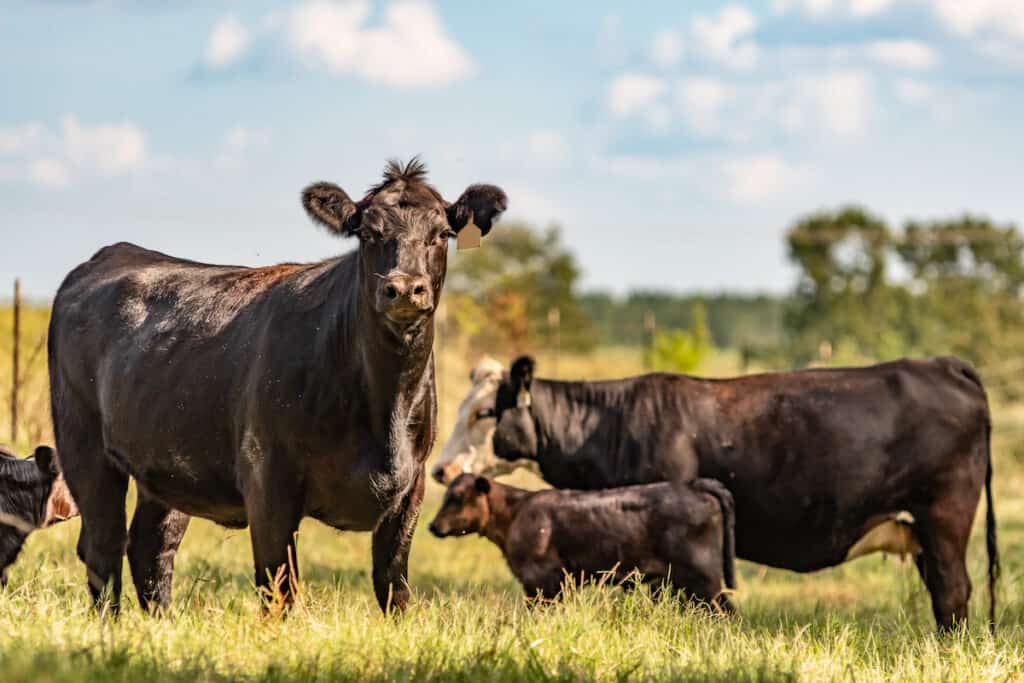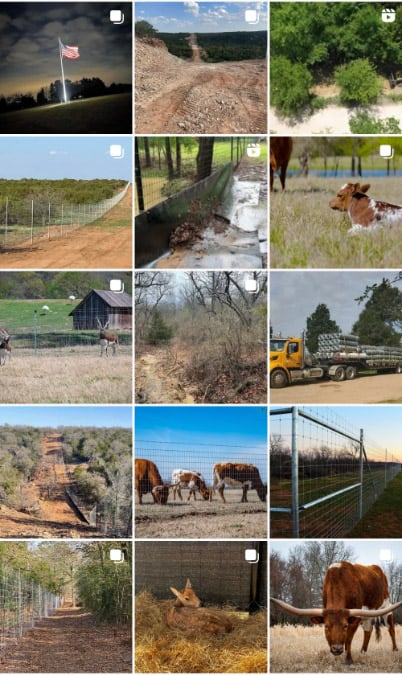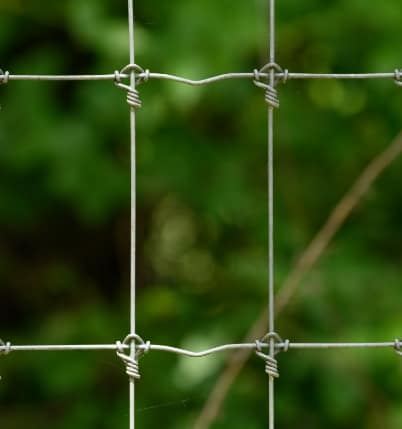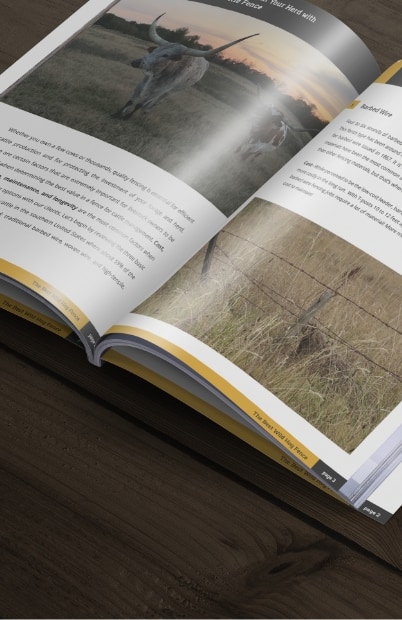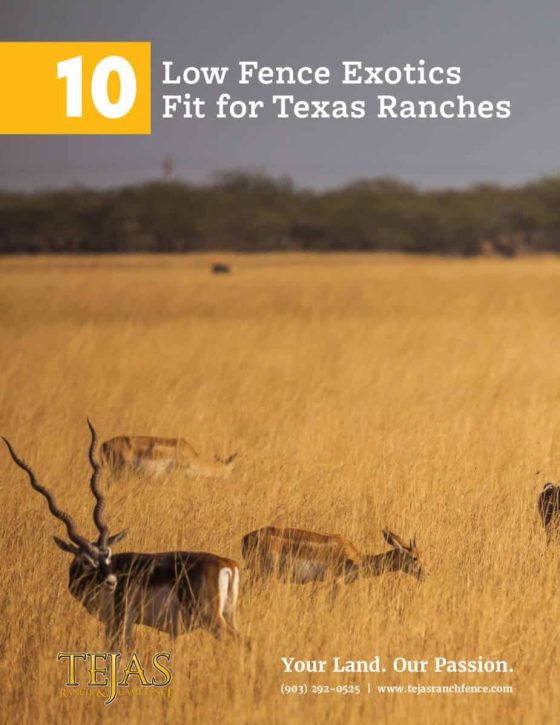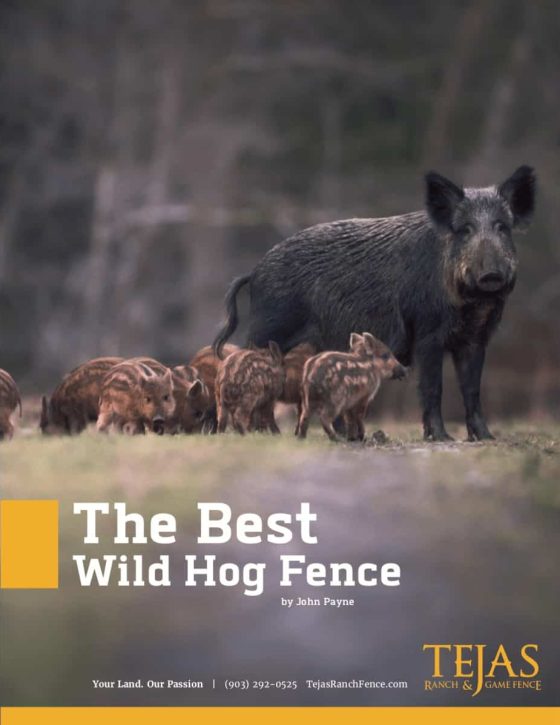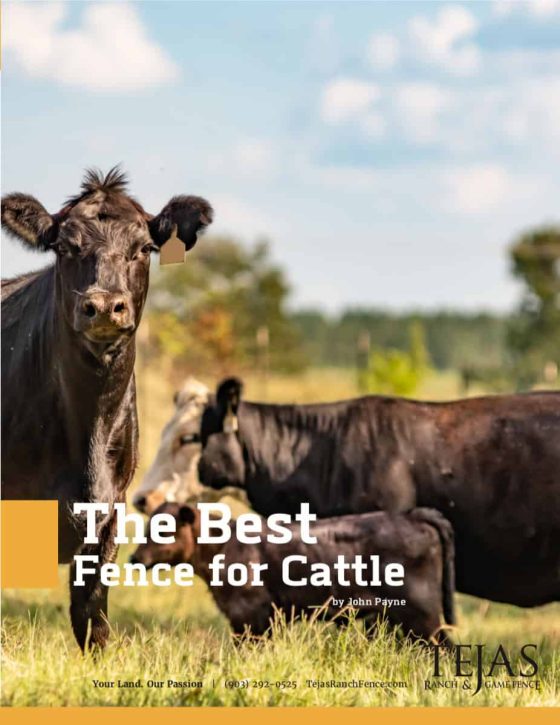Effectively Maintain Your Herd with the Best Fence for Cattle
Whether you own a few cows or thousands, quality fencing is essential for efficient cattle production and for protecting the investment of your forage and herd. There are certain factors that are extremely important for livestock owners to be aware of when determining the best value in a fence for cattle management. Cost, performance, maintenance, and longevity are the most common factors when discussing fencing options with our clients. Let’s begin by reviewing the three basic fence types used for cattle in the southern United States where about 59% of the US beef cows are located: traditional barbed wire, woven wire, and high-tensile, fixed-knot wire.
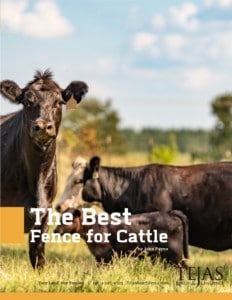 |
Interested in downloading and taking this article with you? Click to download the printable PDF version. |
Types of Cattle Fence Material
1. Barbed Wire
Four to six strands of barbed wire are used to hold cattle for both perimeters and cross fencing. This fence type has been around for more than 150 years, with the first patent in the United States for barbed wire issued in 1867. At Tejas, we acknowledge and respect the role that barbed wire has played in ranch development across America over the years. Even today, it remains the default fence choice for livestock owners because materials have been the most common and it does the job. However, as with most things, improvements in technology are made over time, and cattle fence is no exception. Read on to see how this segment has developed and what is now an easy “best value” decision for ranch managers.
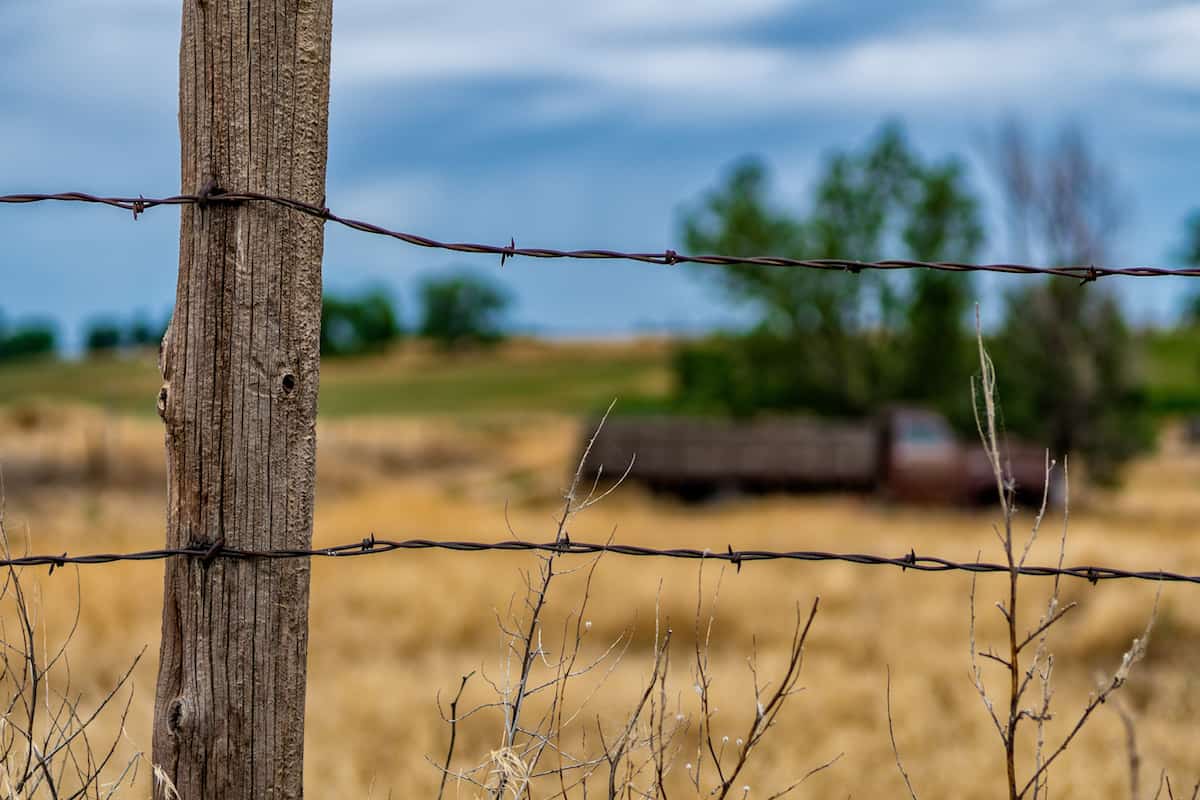
Cost – While perceived to be the low-cost leader, barbed wire is not the lowest cost. With T-posts 10 to 12 feet apart and stays or stiffeners required as well, barbed wire fencing jobs require a lot of material! More material means more initial cost and more cost to maintain!
Performance – The sharp barbs, which are notoriously difficult to see, can injure people and animals, particularly horses.
Another serious consideration is the fact that feral hogs are highly destructive and prolific pests that eat nearly anything, including many species of native wildlife. They also compete with native wildlife by eating acorns, a major fall food source for deer, turkey, and black bears. Their rooting and wallowing behavior destroys landscapes and pollutes ponds, streams, and other waters.
Barbed wire is not a good choice for any animal except large livestock. Wild hogs and other damaging predators can easily pass through a traditional 5-strand barbed wire fence. This is a big shortcoming of this fence, as the feral hog populations continue to increase and cause more property damage, including damage to cattle forage. Nevertheless, landowners have attempted to enhance this barrier for years by using 6-strand fencing on 6-foot T-posts. Initially, these added measures may be somewhat successful in their ability to deter wild hogs and other animals, but because these fences are made from a weak, low-tensile wire, these measures fail over time.
If you plan to sell in the future, it is smart to think about versatility. While barbed wire is sufficient for cattle, horse enthusiasts, who fear their animals will become entangled and injured, frown on barbed wire. If resale is an issue, careful consideration should be given to the type of fencing installed.
Maintenance – The biggest drawback for barbed wire fences is maintenance, which increases costs down the road. Just take a drive through rural America, and before long, you will discover a barbed wire fence in need of repair. Wear and tear caused by wild hogs, deer, coyotes, and livestock can open breaches and cause the fence to fail over time.
Longevity – With adequate maintenance, the standard barbed wire fence with Class 1 galvanization in average use and climate conditions should perform to reasonable expectations for 15 years.
2. Hinged-Joint or “Field Fence”
Over the past few decades in some regions of the country, the go-to ranch fence evolved from barbed wire to “field fencing” made of hinged-joint mesh. With more wire per square foot, the field fence has smaller openings, which are more difficult for unwanted visitors to breach. Horses, sheep, and other animals also are less likely to become entangled in field fencing, making it a more versatile choice for ranchers who raise other livestock in addition to cattle. However, there are some drawbacks to the hinged-joint fence.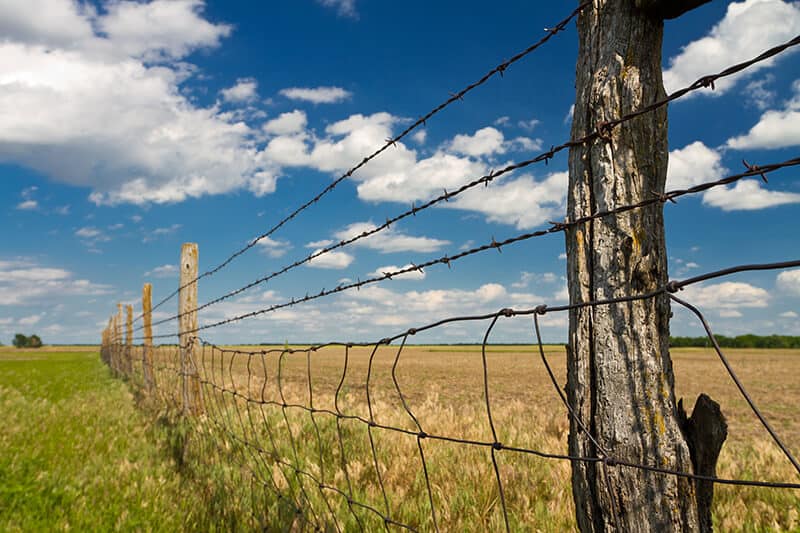
Cost – While materials and labor to construct a hinged-joint field fence are about the same as barbed wire or high-tensile wire mesh, as depicted in the chart below, the shorter lifespan of the system makes it a relatively expensive fence to own.
Performance – Like barbed wire, field fencing can become dilapidated and damaged without regular maintenance. Field fencing has two main flaws: it can lose shape rather quickly, and its weaker wire is subject to breakage caused by rust, weathering, and pressure. Feral hogs can easily wallow holes in the mesh of common field fence material because the hinged joints are relatively weak, as are wires made of low-carbon steel. These inherent weaknesses in the material and construction significantly detract from the usefulness of this type of fencing. Poor performance over the long term offsets initial cost savings.
Maintenance – Hinged joints slip and don’t return to their original shape when livestock, feral hogs, and predators press against the fence. This weakness creates an opportunity for wildlife to work minor holes into large openings. Furthermore, the metal used on these older fences is soft, inadequately galvanized, and prone to rust, which reduces the life of the fence and leads to failure over time. Ultimately, while better than barbed wire in some respects, field fences still require long-term maintenance.
Longevity – With adequate maintenance, the standard hinged joint field fence wire fence with Class 1 galvanization in average use and climate conditions should perform to reasonable expectations for 10 years.
3. High-Tensile Fixed-Knot Wire
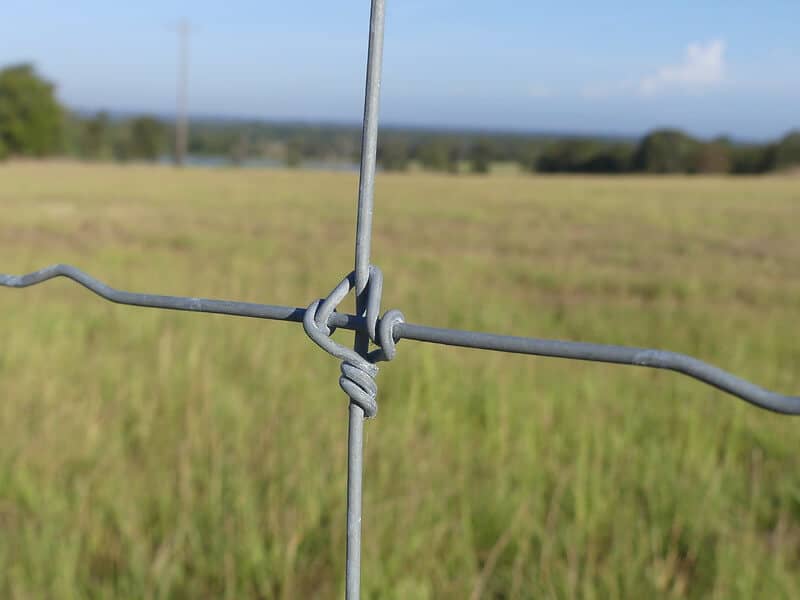 The next-generation cattle fence solution for ranchers and property owners has been in use for more than 10 years and has proven to be the best value winner! High-tensile, fixed-knot cattle fences are excellent for livestock control and outperform traditional barbed wire and hinged-joint fences in every application with superior durability, flexibility, and safety. Even more important, high-tensile, fixed-knot fences last longer than other types of fencing, which saves landowners time and money on maintenance, repairs, and replacement making it the least-cost, best-value fence to own.
The next-generation cattle fence solution for ranchers and property owners has been in use for more than 10 years and has proven to be the best value winner! High-tensile, fixed-knot cattle fences are excellent for livestock control and outperform traditional barbed wire and hinged-joint fences in every application with superior durability, flexibility, and safety. Even more important, high-tensile, fixed-knot fences last longer than other types of fencing, which saves landowners time and money on maintenance, repairs, and replacement making it the least-cost, best-value fence to own.
Let’s dive a little deeper and discuss high-tensile, fixed-knot costs, performance, materials, benefits, specifications, and additional options:
COST OF THE BEST FENCE FOR CATTLE
The selection of the best fence for cattle on a ranch often comes down to a value equation. High-tensile, fixed-knot Class 3 fences provide significant value. Over the long term, these superior fencing materials cost significantly less to install and maintain than Class 1 barbed wire fences or hinged-joint field fences. The initial cost to install fixed-knot fencing is virtually the same as barbed wire because of the 20-foot post spacing, which requires fewer intermediate posts and no fence stays or stiffeners. Also, this fence material comes in rolls of 330 or 660 feet, which facilitates installing long runs versus installing wires individually. After installation, the fixed-knot fence requires little to no maintenance, which translates into significant savings of time and money. With a service life of two to three times that of typical low-carbon barbed wire and hinged-joint fencing, a high-tensile, fixed-knot fence is a no-brainer!
**UPDATE – based on market changes in supply and materials available due to COVID, fence material prices have changed. Please call Tejas for the latest prices.
| $ per L.F. | Braces & Gates | Net Cost Per Mile | Useful Service Life | Annual Cost Per Mile | |
|---|---|---|---|---|---|
| Barbed Wire, 5-strand | $4.74 | $13,415.00 | $31,734.70 | 15 | $2,115.65 |
| Field Fence, Low Tensile | $5.46 | $12,578.00 | $35,117.80 | 10 | $3,511.78 |
| Fixed-Knot, High Tensile 949-6 | $5.42 | $12,578.00 | $34,906.60 | 30 | $1,163.55 |
Chart Conclusion: High-tensile, fixed-knot fence is 100% less expensive to own over time than barbed wire and 200% less than field fencing.
Chart Notes: Service life is based on Class 3 galvanization, which is three times thicker than Class 1 galvanization applied to typical barbed wire. The greater galvanization gives the fencing a much longer useful service life in typical applications.
2-mile basis of comparison using Tejas standards of spacing, galvanized pipe and t-posts.
 |
Interested in downloading and taking this article with you? Click to download the printable PDF version. |
Performance – High-tensile, fixed-knot fence is much better over time. The fence is better for keeping animals in and keeping feral hogs and predators out, making it an easy choice when deciding on a new cattle fence.
Maintenance – Based on the high-tensile wire, fixed-knot construction and Class 3 galvanization, this fence requires minimal maintenance. The combination of high tensile and the strength of the fixed knot make this fence virtually impervious to damage by wild or domestic animals. With proper installation, good maintenance consists of keeping vegetation from growing on the fence where it is not desirable and checking periodically for damage from falling trees. That’s it.
Longevity – With a wide range of height and mesh pattern options, fixed-knot mesh fencing is versatile and can be easily customized to fit the individual needs of the rancher. With the benefits of higher performance and excellent longevity, the net cost per year to install this fence makes it the best value to own.
HIGH-TENSILE, FIXED-KNOT FENCE MATERIALS
High-tensile, woven-wire steel mesh with a “fixed knot” design is the foundation for the best fencing for cattle.
If you don’t want to worry about maintenance, this steel mesh, fixed-knot fencing is the best place to start. High-tensile, woven-wire steel mesh with a “fixed knot” is the material of choice for holding cattle, preferred over five-strand barbed wire and hinged-joint fencing for its strength and safety, and most importantly, for its resistance to breach.
The high-tensile, fixed-knot fence is the next-generation form of the old field fence and consists of a series of interconnected vertical and horizontal wires that form squares and rectangles of overlapping and knotted wires. It differs from field fencing in its strength, longevity, performance, and available patterns.
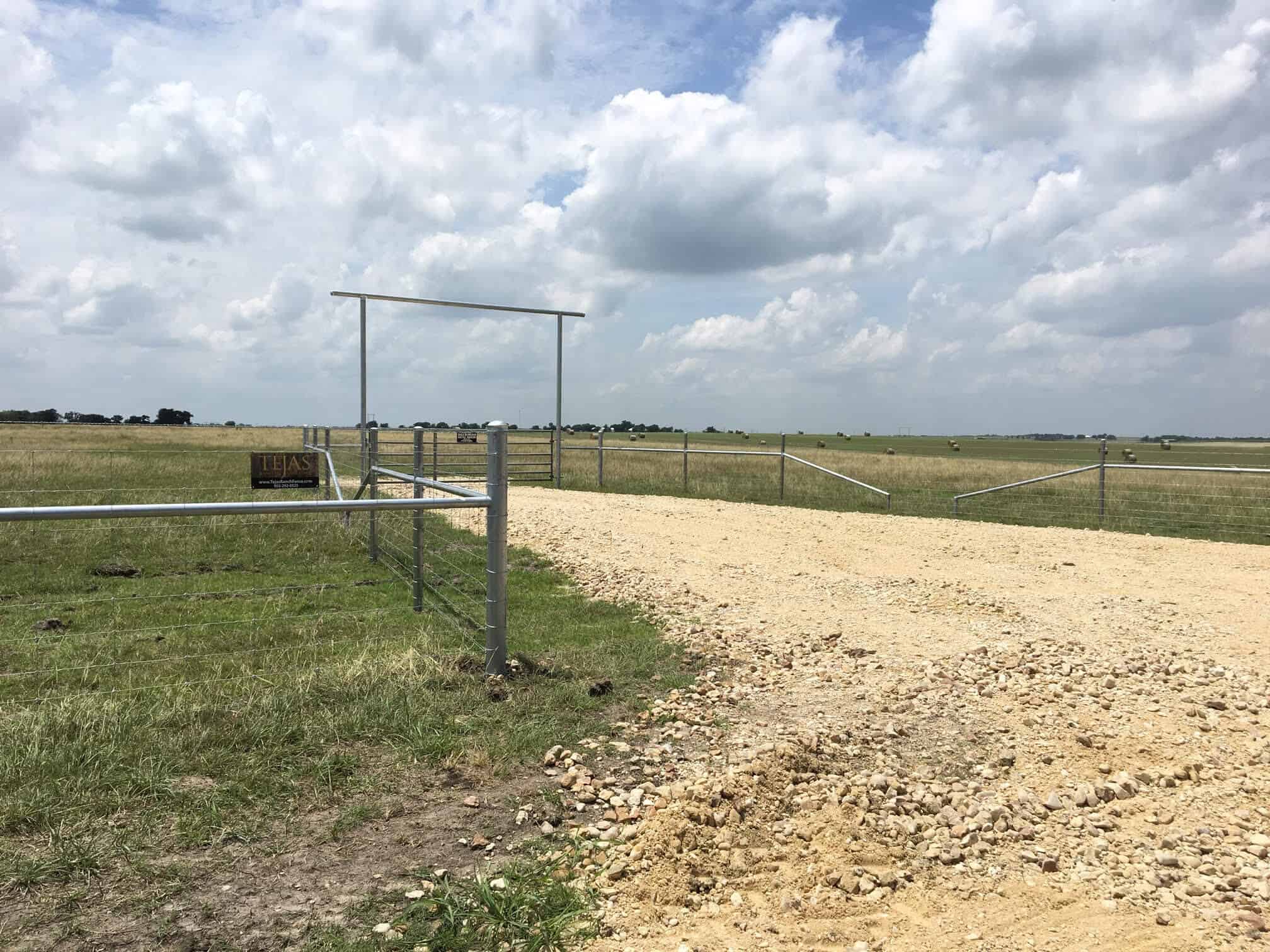
PERFORMANCE OF FIXED-KNOT CATTLE FENCES
A fixed-knot design combined with high-tensile wire makes this the strongest woven-wire fence available. It is highly resistant to animal damage. In fact, the breaking strength of each individual 12-gauge horizontal wire is around 1,380 lbs.
Crimps manufactured in the horizontal wires are installed with significant tension, so they resist force in a spring-like fashion. Fixed knots do not move or loosen under pressure from animals. Wild hogs can’t “wallow” a hole in the fence fabric like they can in traditional low-tensile field fence wire. Additionally, the steel mesh spacing enables the fence to withstand animal stresses without losing shape or strength.
Class 3 galvanized, high-tensile fixed-knot fences require very little maintenance, so landowners spend less time worrying about the integrity and durability of the fence. And in coastal and other environments where salty sea breezes can increase corrosion, these fence meshes are available with a Class 40 Zinc-Aluminum coating. This zinc-aluminum coating provides the highest degree of protection available for high-tensile steel mesh.
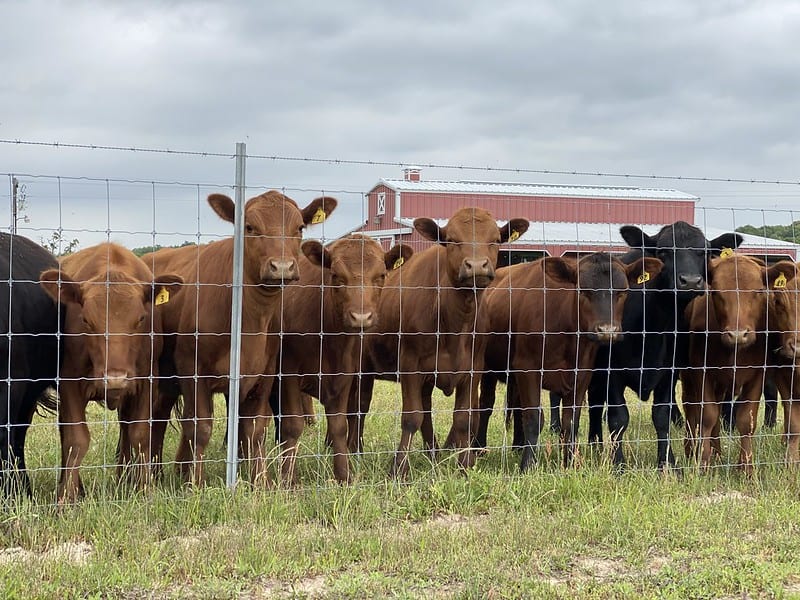
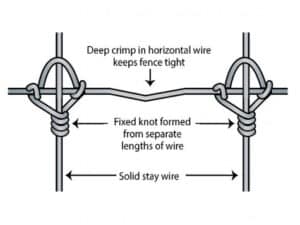 When selecting high-tensile, fixed-knot wire mesh for cattle fences, the four factors that make a performance difference are:
When selecting high-tensile, fixed-knot wire mesh for cattle fences, the four factors that make a performance difference are:
- Fixed-knot design – Fixed-knot wires are wrapped around the line and stay wires for superior vertical strength, which allows for increased post spacing and excellent resistance to animal impact. The fixed-knot union holds tight under pressure, resisting movement and keeping its form to maintain its ability to do its job.
- High-Tensile Wire – Professional grade 12.5-gauge high tensile wire is 175% or 2.75X stronger than traditional low-carbon, 12.5-gauge field fence, providing a breaking strength of 1,380 lbs. vs 500 lbs. per single wire.
- Coating Type – Minimum ASTM Class 3 galvanized coating has three times more galvanization than the typical Class 1 product used on field fences. Using fixed-knot mesh for cattle creates a much longer-lasting fence that performs for up to three times longer.
- Mesh spacing –Fixed-knot, high-tensile mesh designs are available in 3- to 12-inch vertical stay wire spacing with 3-inch minimum and 5-inch maximum horizontal wires in the two bottom courses.
BENEFITS OF HIGH-TENSILE, FIXED-KNOT CATTLE FENCING
- Best Value- Heavy-duty Class 3 galvanized wire contributes to longevity and durability.
- A 20-year manufacturer’s warranty protects the investment.
- Its ability to keep feral hogs out is a massive differentiator and will prove to be more valuable over time.
- Fixed-knot cattle fences can last 3x longer than traditional low-tensile fencing material.
- This type of fencing offers the highest strength to cost ratio.
- Vertical stay wires on 6-inch or tighter centers give the fence high resistance to penetration.
- Posts can be spaced up to 20 feet apart for greater economy while still retaining strength.
- Construction stays tight with less than 1% elongation over the service life of the fence.
- Deep crimping creates memory for optimal flexibility to absorb impact and climate change.
- Properly installed, the high-tensile wire fencing does not sag as other fence materials may.
- High-tensile, fixed-knot cattle fencing is essentially maintenance-free.
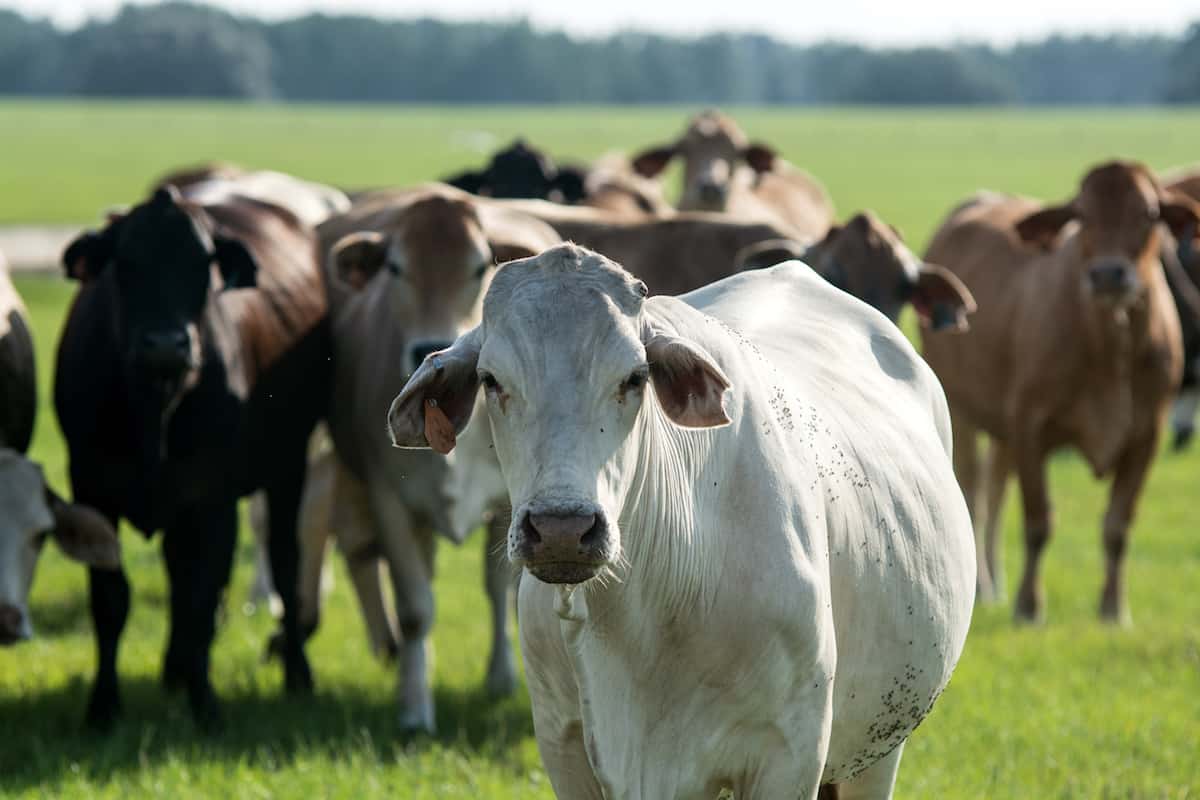
BEST FENCE FOR CATTLE SPECIFICATIONS
Fixed-knot wire comes in many varieties of heights and wire spacing (see fixed-knot fence patterns). For containing cattle, a standard 4- to 4.5-foot height is sufficient. The main choice to consider is the amount of spacing between the wires, both vertically and horizontally. For best results, high-tensile, fixed-knot fence mesh with a spacing of 6 inches or less in the vertical stay wires is recommended. The mesh spacing of 6 inches is sturdier and less susceptible to livestock damage, which makes it a longer lasting choice for a surprisingly small premium in price. Commercial hunting or breeding operations typically use this kind of high-grade, high-tensile, woven-wire steel mesh, but in an 8-foot tall version.
The best cattle fence material has 9 horizontal wires and stands 49 inches tall with a vertical spacing of 6 inches. For high-traffic areas such as corals, turnouts, or birthing pens, 3-inch vertical spacing provides for greater strength and security. The more tightly spaced fencing also is more durable and resistant to pressure in high-traffic areas.
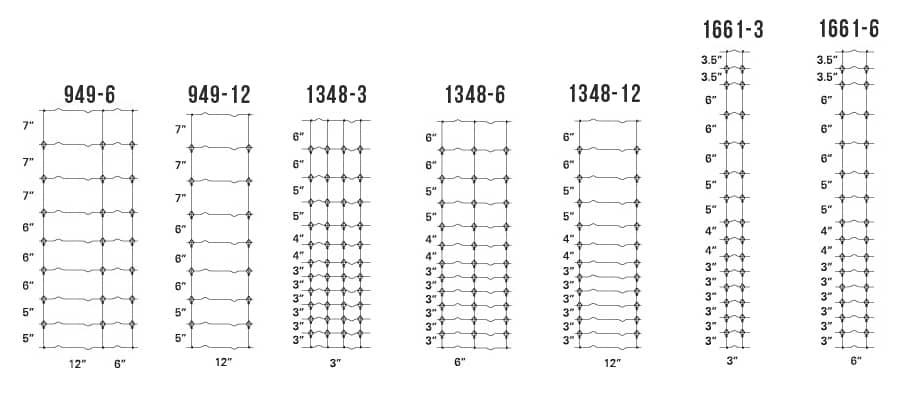
GATES & WATER GAPS FOR THE BEST CATTLE FENCE
Proper design and installation of ranch gates and water gaps are critical to the performance of any fence system. Many factors must be considered to ensure the proper installation of gates and water gaps, as these are the two most important links in the chain of security provided by the fence system. Gates and water gaps are also the most technical aspects and require planning, design, and execution in a way that provides maximum functionality, performance, value, and ease of use by the property owner.
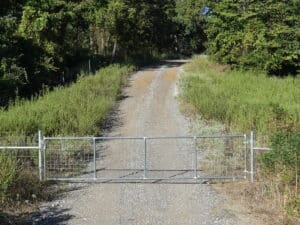 For gate construction, it is important to consider soil type, anchoring system, and stabilization to ensure long-term performance, swing direction, ground elevations, latch system, automation options, ground clearance, maximum open space to match containment or protection criteria, materials, durability, aesthetics, and budget.
For gate construction, it is important to consider soil type, anchoring system, and stabilization to ensure long-term performance, swing direction, ground elevations, latch system, automation options, ground clearance, maximum open space to match containment or protection criteria, materials, durability, aesthetics, and budget.
For water gaps, considerations include watershed analysis, flow rates, debris potential, length and height, maximum flow depth, historical flow data, protection and containment criteria, accessibility, protection criteria, durability, ease of maintenance, ability to conform to changes in the creek or watershed bottom over time, proper fitment, support structure integrity and longevity, and budget.
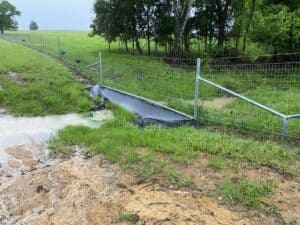
The functionality of these components of a cattle fence is vital to the long-term performance of the fence, which keeps operating costs low over time and reduces the net cost of the investment. A “Done Right the First Time” philosophy typically costs a little more up front but saves countless dollars and headaches in the future. Quality construction and materials take concerns about fencing out of the equation, freeing more time for forage development and cattle production.
The folks at Tejas Ranch & Game Fence use proven methods acquired through years of experience in the business to ensure a good fit and a long-lasting solution with the pride and workmanship that guarantee top performance in the ranch fence world.
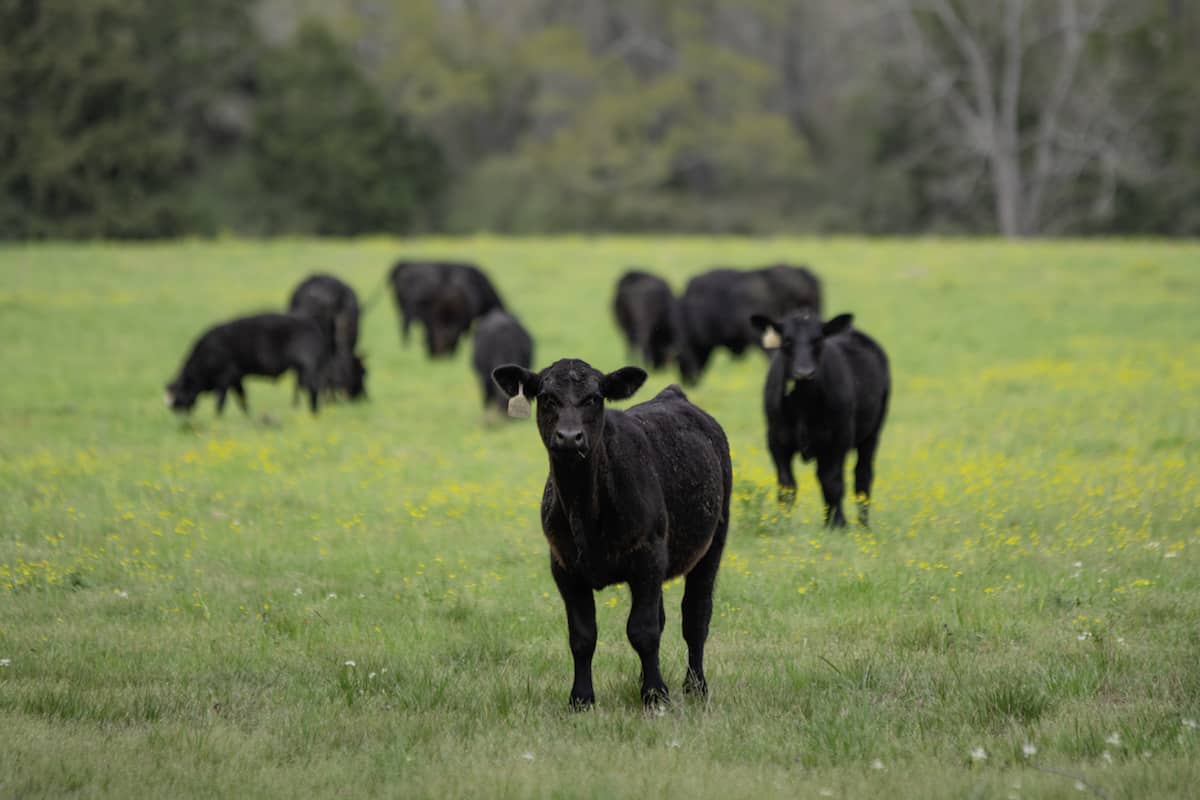
SUPPORT POSTS AND CORNERS
All types of materials, from railroad ties and rock piles to cedar posts and trees, can be used for bracing or fence support. But ad-hoc bracing doesn’t necessarily make a sturdy fence. A good rule of thumb to remember in choosing materials and quality installation for your next cattle fence is that the structural support system sets the foundation for a reliable herd management tool for many decades to come.
Fence Brace Material
The most reliable fence bracing material for farms and ranches is made from galvanized pipe, which provides strength, longevity thanks to a corrosion protective layer, and affordability with an almost maintenance-free, 25-year-plus service life. This post material is used to build H-brace corners, pull posts, and line posts that are the true structure of the fence system. These posts enable high-tensile, fixed-knot wire mesh fencing to maintain its integrity as a reliable barrier.
Structural Brace Construction
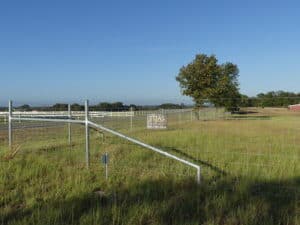 A fundamental bracing method with structural anchors at each terminal and turn point has been around for decades, but in recent years, quality ranch fence contractors have perfected the method. On a typical H-brace or corner brace, a 3-inch galvanized post is driven into the ground anywhere from 5 to 7 feet depending on the soil type and density. It is important to drive the tension-bearing post down to gain ultimate resistance to the soil. Soil types and compaction rates vary, and corresponding construction methods must, as well. With their years of experience and engineering expertise, the professionals at Tejas are adept at setting these critical anchor points to perform for the life of the fence, guaranteed.
A fundamental bracing method with structural anchors at each terminal and turn point has been around for decades, but in recent years, quality ranch fence contractors have perfected the method. On a typical H-brace or corner brace, a 3-inch galvanized post is driven into the ground anywhere from 5 to 7 feet depending on the soil type and density. It is important to drive the tension-bearing post down to gain ultimate resistance to the soil. Soil types and compaction rates vary, and corresponding construction methods must, as well. With their years of experience and engineering expertise, the professionals at Tejas are adept at setting these critical anchor points to perform for the life of the fence, guaranteed.
Once the posts are set, horizontal cross members made of galvanized pipe are welded between the vertical posts, and a diagonal kicker brace is attached to the structure and attached to a deadman for maximum strength of the bracing structure. Pipe welding should be a complete 360 degrees and, when done right, fully penetrate the base metals to create the rigidity to support the 2,000- to 3,000-pound tension of the high-tensile, fixed-knot wire fence without moving.
This construction practice provides a heavy-duty anchoring point for all the tension that will be applied to your cattle fence over the years.
Fence Fabric Support Posts
With a fixed-knot wire mesh fence, we recommend T-post spacing on 20-foot centers. This distance can be slightly more or less depending on a number of variables, including topography, animal traffic, and soil types. The rigidity and vertical stays of a fixed-knot fence allow it to perform extremely well with nominal 20-foot post spacings. The savings realized by 20-foot intervals offset the increased cost of the high-tensile wire and result in a much stronger and longer-lasting product. In high-pressure areas or with cattle that put more pressure on a fence, T-posts and line posts can be spaced on tighter intervals.
Additional fence wire support is added through the use of vertical line posts, which are driven into the ground along the fence line at 100- to 120-foot intervals and take the place of T-posts at those locations. The primary purpose of these line posts is to give the fence fabric good lateral stability on long runs between the primary bracing structures.
 |
Interested in downloading and taking this article with you? Click to download the printable PDF version. |
ADDITIONAL OPTIONS
Predator-Control Barriers
Predator-control barriers can be added to customized fence solutions for almost any environment or need. Predator-control options consist of a steel mesh apron fence at the base of the fixed-knot fence to eliminate digging, tunneling, and wallowing; or electric wire barriers at the base and/or center and top of the fence.
Electric fences
Electrifying an outrigger wire on a high-tensile wire mesh fence adds a belt-and-suspenders approach to exclude feral hogs and deter coyotes. When applied on the inside, the electric wire can work to keep cattle from applying undue pressure on a fence.
An electric fence wire outside of the fence at approximately 6 inches above the ground can prevent dogs and coyotes from digging under a fence and has been shown to considerably reduce breaches.
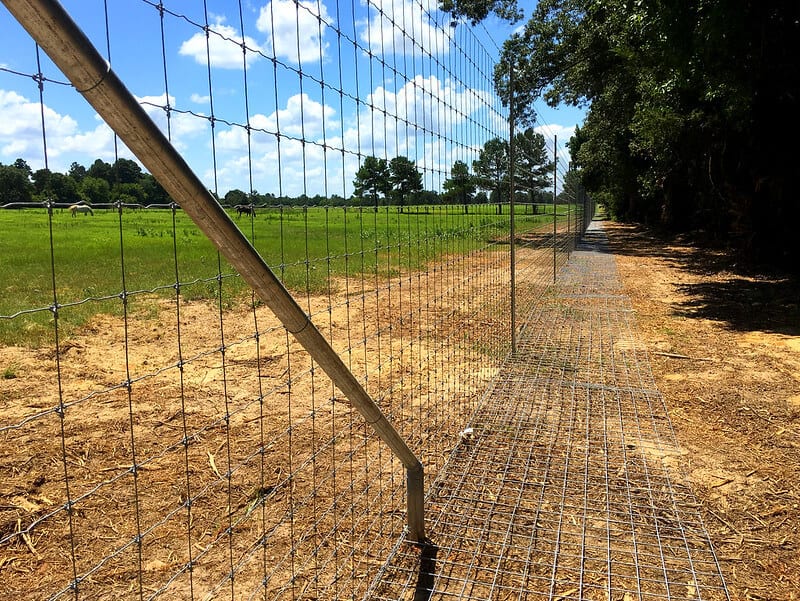
WHY CHOOSE TEJAS?
Choosing the right ranch fence contractor to build the best fence for cattle
The highly skilled team of fencing innovators, designers, and construction professionals at Tejas are dedicated to excellence in every job. They work closely with clients to determine the best design and construction for their unique needs and use only the highest quality fencing materials. Their installation teams are meticulous and accomplished experts in every way. By focusing on careful consultation and design, top-quality materials, and uncompromising installation, Tejas strives to exceed clients’ high expectations to create sustainable value in all solutions. Choose Tejas for the best fence for cattle on your property.

